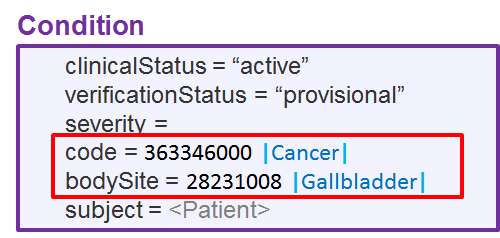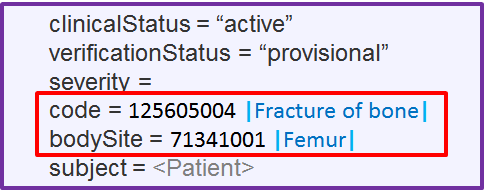These binding patterns are extracted from Linda Bird's presentation from the Bratislava face-to-face meeting.
- Note that binding patterns can be applied to all or a selection of information model elements, e.g. in the examples below the patterns apply to the code and bodySite information model elements, but not e.g. to clinicalStatus or severity. This is a design decision for each resource.
- Note that cardinality of value of information model is not considered. E.g. if code has two finding sites and there are multiple bodySite values?
Meaning provided solely by SNOMED CT (where SNOMED CT is applicable)
Option 1
The meaning of the resource instance is provided by using SNOMED CT only in areas covered by SNOMED CT.
Disallow conflicting representations by disallowing use of information model elements, i.e. cardinality 0..0.
Example:
Impact: would require post-coordination or likely extensive local, national, or international pre-coordination.
Meaning is provided by a mutually constrained combination of multiple SNOMED CT encoded information model elements
Impact: all these options would require software implementing run-time constraint checking between multiple information model elements
Option 2
Allow use of information model element only if there is no "corresponding" (how?) SNOMED CT attribute in a concept definition of a concept used as a value in another information model element.
Example: bodySite = 28231008 |Gallbladder| is allowed only because the definition of 363346000 |Cancer| does not contain the SNOMED CT attribute 363698007 | Finding site (attribute) | AND the information model element bodySite is considered corresponding to the SNOMED CT attribute 363698007 | Finding site (attribute) |.
Option 3
Allow use of information model element only if the case above (Option 2) is fulfilled OR if the attribute formed by the "corresponding" SNOMED CT attribute and the information model element value refines (is subsumed by) a SNOMED CT attribute in a concept definition of a concept used as a value in another information model element.
Example: bodySite = 71341001 | Femur | is allowed because there is a element-attribute correspondance (bodySite - 363698007 | Finding site (attribute) |) and 363698007 | Finding site (attribute) | = 71341001 | Femur | is subsumed by 363698007 |Finding site| = 272673000 |Bone structure (body structure)|.
Option 4
Don't know how to interpret this pattern. Is "<" vs "<<" the only difference?
Option 5
This pattern does e.g. not allow concepts which are primitive children of concepts with non-IsA relationships and thus seems overly restrictive.
Option X+
There are other options for guaranteeing consistency between multiple SNOMED CT-valued information model elements, and hence interoperability:
- the value of one information model element, if it does not exist, is assigned by extracting a value from a SNOMED CT attribute from a concept which is a value of another information model element.
- the value of one information model element, if it does not exist, is assigned or asserted to be equal to or subsumed by an expression which is a templated combination of multiple other information model elemetn values, .
Meaning is provided by a mutually unconstrained combination of multiple SNOMED CT encoded information model elements
Option 6



